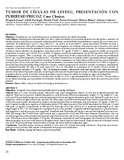Mostrar el registro sencillo del ítem
Tumor de células de leydig, presentación con pubertad precoz
| dc.rights.license | http://creativecommons.org/licenses/by-nc-sa/3.0/ve/ | |
| dc.contributor.author | Araque, Maryuali | |
| dc.contributor.author | Uzcátegui, Lilia | |
| dc.contributor.author | Paoli, Mariela | |
| dc.contributor.author | Petrosino Tepedino, Pierina | |
| dc.contributor.author | Milano Molina, Melisse | |
| dc.contributor.author | Contreras, Adriana | |
| dc.date.accessioned | 2009-09-01T23:00:16Z | |
| dc.date.available | 2009-09-01T23:00:16Z | |
| dc.date.issued | 2009-09-01T23:00:16Z | |
| dc.identifier.issn | 1690-3110 | es_VE |
| dc.identifier.uri | http://www.saber.ula.ve/handle/123456789/29305 | |
| dc.description.abstract | Objetivos: Presentar un caso de pubertad precoz secundaria a tumor de células de Leydig. Caso Clínico: Paciente preescolar masculino de 5 años, quien fue referido por presentar aparición de vello púbico, aumento de tamaño del pene, piel oleosa y crecimiento acelerado para la edad, sin antecedentes de traumatismo craneal o procesos infecciosos cerebrales. Al examen físico: peso 22,7kg y talla 117,2 cm, ambos en el percentil 97, masas musculares evidentes en tórax y miembros superiores, vello púbico tanner II, pene de 6cm de longitud, con volumen testicular de 4 mL el derecho y de 3 mL el izquierdo, observándose mucho adelanto de caracteres sexuales secundarios para el volumen testicular. Los estudios de laboratorio revelaron valores elevados de andrógenos: testosterona libre: 237 ng/dL, 17OHP: 3.7 ng/mL, prueba de GnRH con respuesta prepuberal, no plana (pico de LH: 3,4 y de FSH: 1,8 ng/mL), prueba de estimulación con ACTH reporta 17OHP basal 5.3 y postestímulo 6 ng/mL, TSH: 2,1 mUI/mL, T4L: 1,10 ng/dL. Edad ósea de 10 años, relación EO/EC de 1.9, predicción de talla final de 157 cm, con potencial genético de talla de 169,7. Se planteó Pubertad Precoz Periférica (HAC hiperplasia adonal congénita vs. Gonadal) que desencadenó una pubertad verdadera. Se indicó tratamiento con Triptorelina e Hidrocortisona a dosis habituales por kg de peso. En su evolución clínica, a pesar del tratamiento y mostrando normalización de niveles de 17OHP (1.4 ng/mL) y adecuada supresión del eje Hipotálamo-Hipófisis-Gónada, continuó progresión de caracteres sexuales secundarios, aumentando la asimetría testicular VD: 8mL y VI: 6mL, pene de 9 cm y la velocidad de crecimiento de 12 cm/año. Nuevos niveles de testosterona muy elevados (770 ng/dL). TAC de abdomen normal y ultrasonido testicular reportó LOE sólido en testículo derecho. Marcadores tumorales normales, excepto ligera elevación de Gonadotropina Coriónica. Se realiza orquidectomía derecha y ligadura alta de cordón. El estudio anatomopatológico reportó tumor de células de Leydig sin signos de malignidad. Conclusiones: Los tumores testiculares son muy raros en niños (1 a 2%) y aproximadamente el 1 a 3% de éstos, corresponden a los de células de Leydig, que se presentan con desarrollo somático precoz y virilización progresiva, siendo una causa de precocidad puberal. | es_VE |
| dc.language.iso | es | es_VE |
| dc.rights | info:eu-repo/semantics/openAccess | |
| dc.subject | Niños | es_VE |
| dc.subject | Tumor de células de Leydig | es_VE |
| dc.subject | Pubertad precoz | es_VE |
| dc.title | Tumor de células de leydig, presentación con pubertad precoz | es_VE |
| dc.title.alternative | Leydig cell tumor, presentation with precocious puberty | es_VE |
| dc.type | info:eu-repo/semantics/article | |
| dc.description.abstract1 | Objectives: To report a case of precocious puberty due to a Leydig cell tumor. Clinical Case: A 5 years old male patient, with pubic hair, penis enlargement, oiliness of skin and accelerated growth was referred. There was no previous cranial traumatism or cerebral disease. Physical examination: weight 22,7 kg, height 117,2 cm, both over 97th percentile for age, muscular development in thorax and upper extremities, pubic hair (Tanner II), penis of 6 cm of longitude, volume of right testicle 4 mL and left 3 mL. More signs of pubertal development than would be expected for the size of the testis were evident. The laboratory analysis showed elevated levels of androgens: free testosterone: 237 ng/dL, 17OHP: 3,7 and 5,3 ng/mL basally and 6 ng/mL post stimulation with ACTH, slight response to the GnRH stimulation test (LH peak: 3,4 and FSH peak: 1,8 ng/mL), normal levels of TSH and FT4. Bone age of 10 years, BA/CA of 1,9, predicted adult height of 157 and target height of 169,7 cm. The diagnostic of peripheral precocious puberty (congenital adrenal hyperplasia vs gonadal tumor) that triggered a central precocity was suggested. Treatment with Triptorelin and Hydrocortisone was initiated in usual doses. With this therapy, the 17OHP levels were normal and a suppression of LH and FSH were obtained. Nevertheless, the boy howed progression of the pubertal development, right testicle of 8 mL, left of 6 mL, penis of 9 cm and growth velocity of 12 cm/year. Testosterone levels were higher (770 ng/dL). Abdominal computerized axial tomography was normal and the testicular ultrasonography disclosed a solid tumor in the right testicle. Tumor markers were normal. Surgical removal of the right testicle was done. The histopathology study revealed a Leydig cell tumor without malignancy signs. Conclusions: Testicular tumors are rare in children (1 a 2%) and 1-3% of them are Leydig cell tumors. They may cause incomplete precocious puberty with somatic development and progressive virilization. | es_VE |
| dc.description.colacion | 26-29 | es_VE |
| dc.description.email | uzcateguilr@hotmail.com | es_VE |
| dc.description.email | pierina@intercable.net.ve | es_VE |
| dc.subject.dependencia | Sociedad Venezolana de Endocrinología y Metabolismo | es_VE |
| dc.subject.facultad | Facultad de Medicina | es_VE |
| dc.subject.keywords | Children | es_VE |
| dc.subject.keywords | Leydig cell tumors | es_VE |
| dc.subject.keywords | Precocious puberty | es_VE |
| dc.subject.publicacionelectronica | Revista Venezolana de Endocrinología y Metabolismo | es_VE |
| dc.subject.seccion | Revista Venezolana de Endocrinología y Metabolismo: Trabajos Originales | es_VE |
| dc.subject.thematiccategory | Medicina y Salud | es_VE |
| dc.subject.tipo | Revistas | es_VE |
| dc.type.media | Texto | es_VE |



